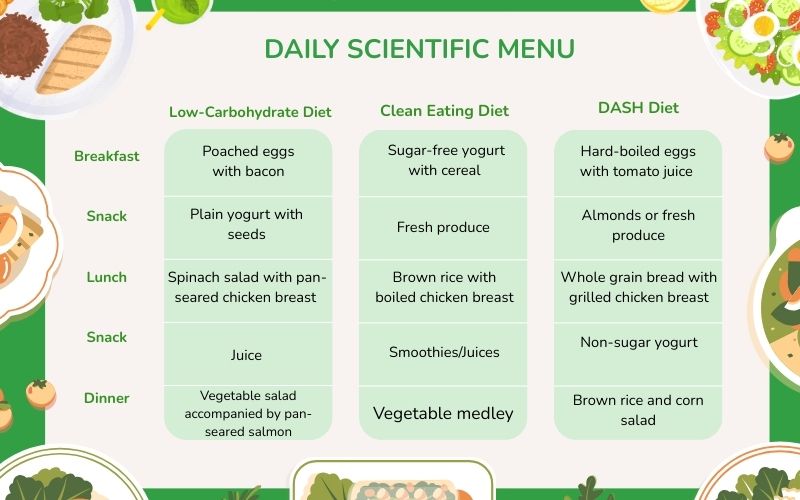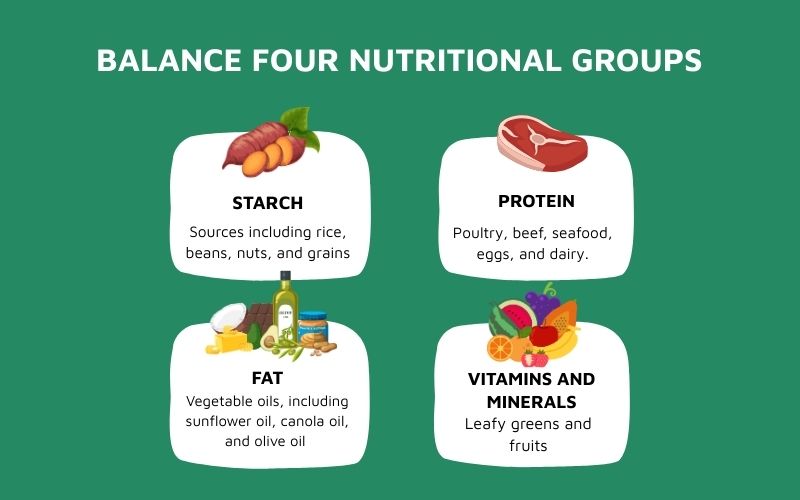A scientific meal plan plays a pivotal role in maintaining optimal health and energy. It’s a balanced combination of nutrient groups, ensuring the body receives all the necessary nutrients for every activity. So, how can you build a scientific yet easy-to-follow daily meal plan? Let Kamereo explore the secrets and basic principles to create the most effective scientific daily meal plan!
Scientific Daily Meal Plan Regimens
To refresh your daily menu effectively while ensuring adequate nutrient supply, here are some suggestions for scientific meal plans you can consider:

Low-Carb Diet
The Low-Carb diet is a dietary adjustment method that reduces carbohydrate intake while maintaining or increasing protein and fat. The basic principle of this regimen is to create a calorie deficit, encouraging the body to use excess fat for energy, thereby supporting weight loss.
Rules
To implement a Low-Carb diet effectively and safely, you need to follow these rules:
- Control carbohydrate reduction
- Prioritize protein and limit fat
- Supplement vitamins and minerals
Suggested Menu
Below is a suggested daily Low-Carb menu for your reference:
- Breakfast: One boiled egg combined with bacon.
- Snack: A small serving of nuts like almonds, walnuts with unsweetened yogurt.
- Lunch: Spinach salad and pan-seared chicken breast.
- Snack: A glass of orange juice or celery juice.
- Dinner: Mixed vegetable salad and pan-seared salmon.
Note that this is just a suggestion; you can adjust the menu to suit your personal preferences and needs. Additionally, you should consult a nutritionist to create a safe and appropriate Low-Carb eating plan.
Eat Clean Diet
The Eat Clean diet focuses on using fresh, clean foods and minimizing processed foods and those high in oil and fat. Preferred cooking methods are usually boiling, steaming, or making salads to preserve the maximum nutrients and natural flavors of the ingredients.
Rules
To build an effective Eat Clean menu, you need to follow these principles:
- Prepare meals at home
- Supplement diverse natural foods
- Combine with appropriate exercise
Suggested Menu
Below is a suggestion for a scientific Eat Clean menu that you can refer to and adjust to suit your personal preferences and needs:
- Breakfast: 1 cup of unsweetened yogurt combined with half a pack of whole grains.
- Light meal: A fresh fruit like an orange, banana, or pear.
- Lunch: 1 bowl of brown rice with about 150g of boiled chicken breast.
- Snack: A glass of avocado smoothie or fresh apple juice.
- Dinner: 1 plate of mixed green salad with lettuce, tomatoes, and other green vegetables as preferred.
DASH Diet
The DASH diet focuses on increasing the consumption of healthy foods such as fruits and vegetables and reducing the amount of red meat in the daily diet. Additionally, DASH encourages limiting salt, saturated fats, food additives, and sweets.
Rules
To build an effective DASH menu, you need to adhere to the following principles:
- Reduce salt intake
- Prioritize whole grains
- Divide meals into 5 per day, including 3 main meals and 2 snacks
- Limit sweet consumption to no more than 5 times per week
- Increase green vegetables
Suggested Menu
Here is a suggested daily menu following the DASH diet that you can refer to:
- Breakfast: 2 boiled eggs and 1 glass of tomato juice.
- Morning snack: A handful of almonds or a fresh fruit.
- Lunch: Whole-wheat bread and pan-seared chicken breast.
- Afternoon snack: A cup of unsweetened yogurt.
- Dinner: Brown rice and corn kernel salad.
Principles for Establishing a Scientific Daily Meal Plan
Here are the fundamental principles that play a key role in establishing a scientific daily meal plan:
Balance 4 Nutrient Groups
To build a scientific daily menu, you first need to ensure a balance of the following 4 essential nutrient groups:
- Carbohydrates: Sources like rice, beans, nuts, and grains provide the main energy for body activities.
- Protein: Red meat, fish, eggs, and milk help boost immunity, helping prevent diseases.
- Fats: Vegetable oils such as sunflower oil, canola oil, and olive oil are beneficial for maintaining cardiovascular health.
- Vitamins and minerals: Green vegetables and fruits facilitate nutrient absorption and overall body development.

Establish Daily Eating Times
To optimize the effectiveness of your daily nutritional regimen, in addition to building a scientific menu, establishing reasonable eating times plays an important role in maintaining the body’s physiological balance:
- Breakfast: From 7:00 to 7:30.
- Morning snack: From 9:30 to 10:00.
- Lunch: From 11:30 to 12:30.
- Afternoon snack: From 15:30 to 16:00.
- Dinner: From 18:00 to 18:45.

Provide Appropriate Calorie Intake
Each individual’s energy needs are not uniform but are influenced by factors such as age, activity level, and current weight. Therefore, calculating and adjusting the calorie content in your daily menu is necessary to achieve nutritional goals, whether for effective weight loss or gain.
Suitable for Each Age
Differences in nutritional needs, absorption capacity, medical history, and health status at each age are also an important principle to consider when building a menu. A scientific diet needs to be personalized to best meet the specific physiological factors of each stage. For example, a menu for developing adolescents will differ from that for the elderly.
Combine Water Intake and Exercise
With the body composed of up to 70% water, maintaining the necessary water intake, about 2 liters per day for adults, not only helps metabolism run smoothly but also adds no calories. Simultaneously, regular exercise is an important factor in improving overall health and maintaining a balanced physique.

Absorbed Energy Less Than Consumed
Another important principle in building a scientific menu is to control the calorie intake. The amount of calories consumed should be greater than the calories absorbed from food. Besides choosing low-energy foods, you should also exercise to help increase calorie expenditure. However, note that reducing calories does not mean fasting, because if you consume less than 1200 calories per day, it can lead to weakness and fatigue.
Adjust Spice Levels Appropriately
In Vietnamese cuisine, high spice consumption is a common characteristic, leading to sodium intake often exceeding the recommended 5g/day. Health experts warn that excess sodium can increase the risk of cardiovascular diseases. Therefore, to protect your health, you should consider reducing spices in cooking and using dipping sauces.
Add Milk to Your Diet
Milk is a rich source of essential nutrients such as iron, calcium, and protein. Combining milk with products like yogurt and cheese not only diversifies meals but also helps ensure the body receives enough important nutrients, supporting overall health.

Conclusion
Thus, maintaining a scientific daily meal plan is the foundation for building a healthy lifestyle. By making smart food choices, your body will be nourished best, while maintaining an ideal weight. Additionally, to gain more useful knowledge about comprehensive health and beauty care, explore the Healthy and Beautiful section on Kamereo now!
See more:



